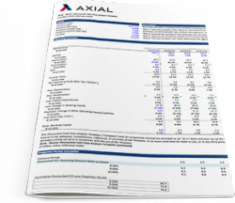
Estimate Your Company’s Value in 20 Minutes
As a business owner, you focus on a number of things – building a brand, developing new products, and increasing your take-home pay – but your long term goal is always the same. You’re trying to increase the value of your business.
At some point, you will sell or pass on your business. The bigger and more valuable your business, the better your options. Being able to understand your value today is critical to making the best decisions and maximizing value in the future. This is why we have put together a simple excel model to help you estimate the value of your company.
Use this template (found at the bottom of the post) to experiment with different assumptions and situations so you can better understand how your decisions affect the value of your company.
How does the model work?
The model we’ve created is a simplified version of a ‘discounted cash flow analysis’ used by investment bankers, private equity professionals, venture capitalists, and other investors to value your business. The idea is that by looking at the total cash flow of your business today and projecting how the business will grow over the next 10 years, you can determine the present value of your company. Then, using the projected value of your business in the future combined with an expected rate of return on capital, we can calculate the “net present value” of your future business. That way, rather than just selling based on this year’s or the next couple of year’s earnings, you can have a better idea about what the future profits are worth, discounted to the present day.
The model is best for maturing businesses with fairly stable cash-flows or with predictable growth rates. Businesses that swing wildly are hard to project in a simplified model and it would be best to work with an investment banker or business broker in your region to find a more accurate valuation for your business.
If you’d like to learn how the model works, step-by-step, sign up for our Business Valuation Webinar.
Explaining a few terms in the model
While many of the terms in our model will be familiar, including revenue, tax rate and working capital, some of the terms might be a bit unfamiliar. Here are the definitions and why we use them:
EBITDA
Earnings Before Interest, Tax, Depreciation, and Amortization. Think of the number as your profits after paying for goods and your staff, but before you pay back anyone else. The number is used because it often represents the maximum amount your business can bear in loan interest. If you spend all of the money on loan interest, none of it goes to taxes. Amortization and Depreciation don’t actually affect free cash, they are instead accounting measures.
Amortization
Usually applying to intangible assets or loans, amortization allows you to account for the cost over a longer period of time than just the period in which you made a lump sum payment. For example, if you acquired a patent from another company, the value of the patent could be amortized over the next few years rather than being accounted for only in the period in which you paid the lump sum. Your accountant or CFO probably knows this number since it doesn’t necessarily affect cashflow but does affect your taxes.
Depreciation
Like amortization, it doesn’t directly affect your free cash, but it does affect your taxes. Depreciation is the amount you’re allowed to write down the value of an asset over time. For example, if a computer costs $1000 and has a working life of three years, it would depreciate $333 per year. You’ll probably need to get this from your accountant or CFO as well.
Interest Rate (Discount Rate)
This number is usually what’s termed your “weighted average cost of capital”, or WACC, which refers to the average interest rate you pay for all of the loans you are able to get to grow your business. This usually includes your term loans, revolvers, and any other outstanding debt. The easiest number to use for a simple, rough projection is the rate at which you’re likely to receive your next loan.
Short Term Growth Rate
The growth rate that your company has had over the last year, or better yet, the average growth rate of your company over the last three years. The short term growth rate is usually a reflection of the growth of a younger company that is still accelerating faster than the industry average.
Long Term Growth Rate
The long term growth rate of your company will usually start to approach the growth rate of your industry over time. Industries have different long-term growth rates; for example, software companies tend to grow faster than media companies at scale. Use the average growth rate of your industry.
Assumptions of the Model
This model is not the actual value of your company, it’s just one way to get an idea about a rough valuation. The true value of your company is whatever someone will pay you for it. There are a number of assumptions in the model and many things we left out that could significantly affect the value of your company.
It’s best to consult with an investment banker who specializes in your industry and region in order to get a better understanding for the value of your business at any given time.